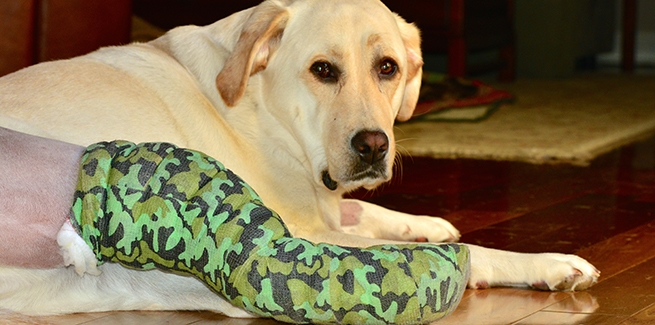Casting for answers to soft tissue complications

The same cast that can help heal a broken limb can lead to complications such as pressure sores, edema, and dermatitis—complications that can mean prolonged pain for the patient, and, in rare cases, amputation of the affected limb.
Researchers at Colorado State University (CSU) wanted to know if there was a better way to cast limbs that might decrease those secondary injuries.
Taller casts could do the trick, according to a new study funded by Morris Animal Foundation.
Traditionally, dogs with hind leg conditions would be fit with casts that immobilize the limb from the joints above and below the condition.
The CSU researchers outfitted 13 dogs with pressure sensors on their legs to measure the amount of force they felt while wearing casts of two different lengths. The sensors were placed over the calcaneus and cranial tibial surface. Then dogs were fitted with a tall fiberglass cast extending from the toes to the stifle joint.
After placing the dogs on a gait analysis mat to ensure they were fully using the casted leg, the researchers measured the amount of force exerted on the sensors inside the tall cast.
Then, they shortened the casts so that they stretched from the dogs’ toes to just above the calcaneus and measured again.
The researchers found that the shorter cast created almost twice the level of average pressure as the taller cast.
Researchers concluded that this was because the longer cast distributed pressure evenly over nearly the full length of the limb, instead of distributing it over a shorter area on thin tissue covering bony protrusions.
Felix M. Duerr, DVM, MS, assistant professor of small animal orthopedics and sports medicine at CSU’s College of Veterinary Medicine and Biomedical Sciences, and principal investigator of the study said, “What we found is clinically significant because we conducted this research over the course of a few walks, but dogs are usually going to walk around in a cast for six to eight weeks, so the level of pressure is going to multiply exponentially.”
This has implications for minimizing secondary complications when treating hind limb injuries and during postsurgical follow up.
“For veterinarians, we would advise going as high on the tibia as you can when making casts like these for the good of the dogs in their care,” Duerr said.
Photo credit: © mauinow1



